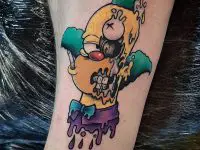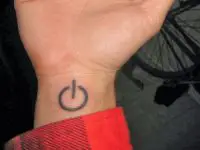Getting a tattoo can come with certain risks, as it involves breaking the skin and introducing ink into the body. There are several risks associated with getting a tattoo, including:
Infection: Tattoos involve breaking the skin, which can lead to bacterial or viral infections, such as staph or hepatitis B and C. To reduce the risk of infection, it is important to make sure the tattoo artist is using sterile equipment and that the tattoo studio is clean and follows proper sanitation guidelines.
Allergic reactions: Some people may experience an allergic reaction to the tattoo ink, which can cause redness, itching, and swelling. In rare cases, an allergic reaction can lead to anaphylaxis, which is a severe and potentially life-threatening reaction.
Scarring: Tattooing can cause scarring, which can be more likely if the tattoo is applied too deeply or if the tattoo artist is not skilled. In some cases, scarring can cause the tattoo to appear distorted and blurred.
MRI complications: Certain tattoo inks contain metals, such as iron oxide, which can heat up and cause burns during an MRI scan. Before undergoing an MRI scan, it is important to inform the technologist if you have any tattoos, so they can take the necessary precautions.
Risk of blood-borne diseases: Unsterile equipment and reused needles can transmit blood-borne diseases such as hepatitis B, hepatitis C, and HIV.
Removal problems: Tattoos are permanent. In some cases, people might regret or be dissatisfied with their tattoo and desire removal. Removal can be done with a laser or surgical method and it can be painful, costly, and not always successful.
How can you minimize the risk of infection when getting a tattoo?
There are several steps you can take to minimize the risk of infection when getting a tattoo:
- Choose a reputable tattoo artist and shop: A reputable tattoo artist will follow proper sanitation and sterilization guidelines, which can help to reduce the risk of infection. Make sure the tattoo shop is clean and well-maintained. Ask to see the artist’s autoclave, where the needles and equipment are sterilized.
- Make sure the artist uses new needles: A new needle should be used for each customer, and the needle should be properly sterilized before use.
- Check the ink: Make sure the artist is using ink that is safe for use in the skin and that the ink is stored properly, in a clean and sealed container.
- Don’t pick or scratch at the tattoo: During the healing process, it’s important to avoid picking or scratching at the tattoo, as this can introduce bacteria into the wound and increase the risk of infection.
- Follow proper aftercare instructions: Your tattoo artist will give you instructions for aftercare, which may include cleaning the tattoo several times a day with mild soap and water, keeping the tattoo moisturized, and avoiding exposure to direct sunlight.
- Watch for signs of infection: If you notice redness, swelling, pus, or fever, seek medical attention. Even if you follow all of the recommended aftercare, it is still important to be aware of signs of infection and seek medical help if necessary.
- Get Vaccinated: Some tattoo parlors require clients to get vaccinated for Hepatitis B. This is a good idea as it can help minimize the risk of infection as well.
It’s important to keep in mind that even when you take all the necessary precautions, it’s still possible to get an infection. So it is important to pay close attention to the healing process and seek medical help if you notice any signs of infection.
How can I find out if I am allergic to tattoo ink?
The best way to determine if you are allergic to tattoo ink is to get a patch test. A patch test involves applying a small amount of the tattoo ink to a small area of your skin, usually on the inner forearm, and observing it for any reactions over the course of several days. This can help you determine if you are allergic to a specific ink color or brand.
Here are a few steps you can take to conduct a patch test:
- Choose a small area on your skin: It’s best to do the patch test on the inner forearm as it’s an area that is not easily exposed to sunlight and has fewer oils.
- Clean the area thoroughly: Make sure the area is clean and dry before you apply the ink.
- Apply the ink: Use a sterile needle to apply a small amount of the tattoo ink to the patch test area.
- Observe the area: Observe the area for any signs of an allergic reaction, such as redness, itching, or swelling, over the course of several days.
- Repeat the test with different inks: If you don’t have any reaction to one ink, repeat the test with a different color or brand of ink to see if you have an allergic reaction to them as well.
It’s also important to note that not all people may develop an allergic reaction during or after the tattoo, but some may develop it later in life, so it is important to pay attention to your skin over time.
It’s worth noting that before getting a tattoo, you should tell your tattoo artist if you have any known allergies, or if you have had an allergic reaction to a previous tattoo. It’s also advisable to wait a couple of days after the patch test before getting tattooed. If you do develop an allergic reaction, seek medical attention and do not proceed with getting the tattoo.
How can you minimize the risk of scarring when getting a tattoo?
There are several ways to minimize the risk of scarring when getting a tattoo:
- Choose a reputable tattoo artist: A skilled and experienced tattoo artist is less likely to cause scarring, as they will use the proper technique and have a better understanding of the healing process.
- Make sure the tattoo artist is using sterile equipment: Sterilized equipment is less likely to introduce infection, which can cause scarring.
- Avoid placing tattoos over bones or joints: Areas that have a lot of movement, such as the spine, wrist, and ankle are more likely to cause scarring.
- Avoid removing a scab: Letting a scab form and fall off on its own is the best way to avoid scarring as it helps to protect the wound during the healing process.
- Keep the tattoo clean and moisturized: Proper aftercare is essential in preventing infection and scarring. Keeping the tattoo clean and moisturized can help to minimize scabbing and reduce the likelihood of scarring.
- Avoid Sun exposure: Sun exposure can cause the skin to become dry, which can lead to scarring. It is important to protect the tattooed area from the sun during the healing process and to always use sunblock to protect the tattooed skin from UV rays.
- Be patient: It takes time for a tattoo to heal, and it’s essential to let the skin heal properly before exposing it to heavy activity. This will reduce the likelihood of scarring and help the tattoo to heal more efficiently.
It’s important to keep in mind that scarring can happen to anyone regardless of the artist or the aftercare, and it may not always be visible. If you suspect that you have a scar, you should consult a dermatologist or a tattoo artist. They can provide you with more information about the healing process and help to minimize any scars.
It is important to choose a reputable tattoo artist who is licensed and follows proper safety guidelines and to carefully consider the design and placement of the tattoo before getting inked. Additionally, it is important to follow proper aftercare instructions to minimize the risk of complications.























0 Comments